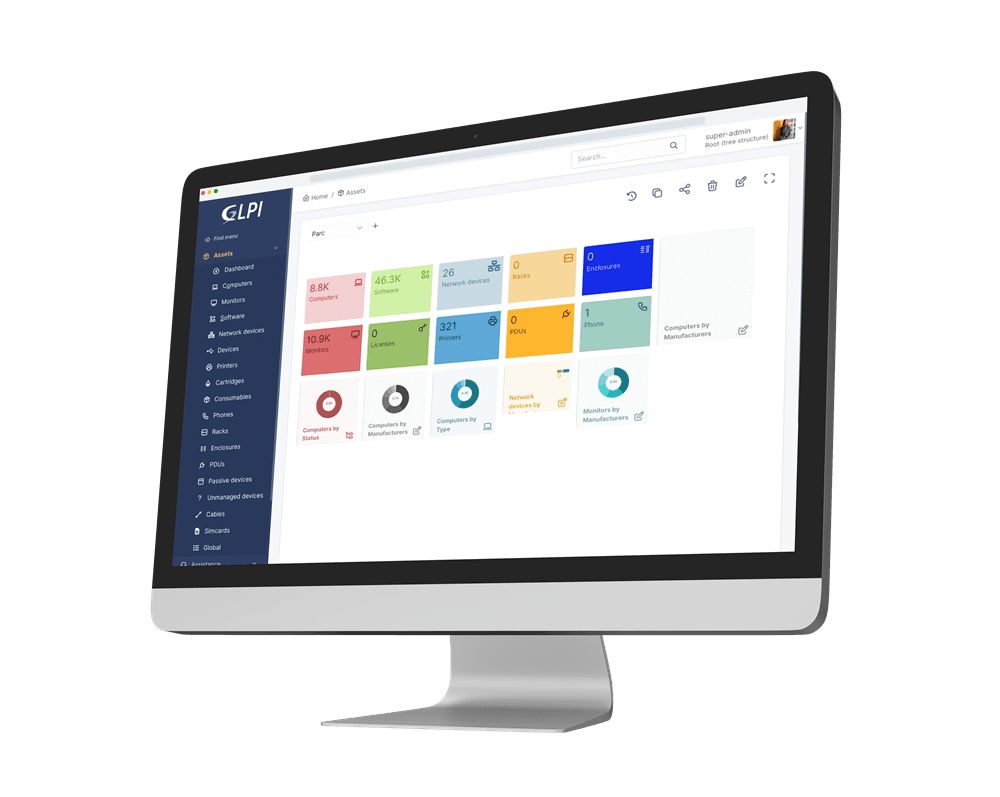Welcome to Hawatel's blog!
September 13, 2024 | General / Infrastructure management / Monitoring / Software
Advanced IT asset management with GLPI: Best practices and case studies
GLPI (Gestionnaire Libre de Parc Informatique) is an open-source tool that is increasingly popular among companies seeking solutions to manage their IT assets. GLPI not only allows for monitoring hardware and software but also for tracking incidents, managing licenses, and even overseeing IT projects.
One of the main reasons GLPI is gaining recognition in the IT industry is its flexibility and ability to adapt to the specific needs of organizations. With a wide range of features, GLPI can be used by both small and large enterprises, adjusting to their unique requirements. In this article, we will discuss how to configure and optimize GLPI in large IT environments, as well as how to automate processes and integrate GLPI with other systems.

Configuration and optimization of GLPI in large IT environments
Implementing GLPI in large organizations requires proper planning and configuration. A key element is understanding the organizational structure and the specific needs regarding IT asset management. Here are some steps to take when configuring GLPI in large IT environments:
- Mapping IT infrastructure: The first step is to map out the IT infrastructure thoroughly, including servers, computers, network devices, and software licenses. GLPI allows for the creation of detailed reports that can help provide better insights into the status of assets.
- User permission customization: In large organizations, managing access to data is crucial. GLPI allows for the creation of various user roles and the assignment of appropriate permissions, minimizing the risk of unauthorized access to sensitive data.
- Performance optimization: In large IT environments, system performance is key. GLPI offers several optimization options, such as database management and configuring the web server hosting the application. Regular monitoring of system performance and making necessary adjustments is also recommended.
- Managing updates and plugins: GLPI is open-source software, meaning new updates and plugins are released regularly. Keeping track of these changes and implementing them ensures access to the latest features and security fixes.

Source: GLPI
Process automation: How to use GLPI for automated asset tracking
One of the biggest challenges in IT asset management is manually tracking hardware and software. GLPI offers advanced automation features that can significantly simplify this process. For example, automatic device detection integrates GLPI with tools like FusionInventory or OCS Inventory, enabling the automatic detection of new devices connected to the network, eliminating the need to manually add assets.
Another feature is automated updates, which regularly check the status of software licenses or firmware updates, providing up-to-date information on IT assets. In large organizations, where managing asset assignments to employees can be complex, GLPI enables automatic asset allocation based on specific rules, such as the employee's role or department. Additionally, GLPI’s automation of incident reporting and resolution processes allows for the automatic assignment of tickets to appropriate departments and tracking progress, essential for efficient IT management.
Integrations with other systems: Utilizing GLPI's API
One of GLPI's greatest strengths is its ability to integrate with other systems via its API, expanding its functionality and adapting it to an organization's specific needs. An example is integration with ERP systems, which many organizations use to manage their assets. The GLPI API allows for automatic synchronization of IT asset data with other ERP modules, such as finance or human resources. Another possibility is integration with monitoring tools like Zabbix or Nagios, enabling automatic ticket creation in GLPI based on alerts generated by these systems.
GLPI can also be integrated with project management tools such as Jira or Trello, improving IT asset management within the context of projects. Furthermore, GLPI can be integrated with business process automation tools like Zapier or Integromat, allowing for the creation of advanced automations that integrate various systems used within the organization.

Source: GLPI
Case study: Examples of effective use of GLPI in tech companies
To better understand GLPI’s potential, here are some examples of tech companies that have successfully implemented GLPI for IT asset management:
- Proma Group, an international company specializing in automotive components, implemented GLPI to manage its global operations, starting in Brazil. The tool was integrated with FusionInventory, allowing for the management of over 1,700 assets across different locations. The ability to quickly locate devices and GLPI's multilingual support helped streamline asset management processes, leading to more efficient decision-making (source: GLPI Project).
- Paris Nanterre University, managing over 2,200 assets, used GLPI to manage its IT infrastructure on a large campus. Integration with monitoring tools allowed the university's IT department to track the status of equipment and ensure timely maintenance, which contributed to increased operational efficiency (source: GLPI Project).
- Cuban telecom operator ETECSA, managing a vast IT infrastructure comprising over 60,000 assets, used GLPI integrated with other monitoring and inventory tools like FusionInventory. This enabled ETECSA to automate asset tracking and maintenance, significantly reducing manual work and improving the accuracy of asset records, leading to better service quality and faster response times to technical issues (source: GLPI Project and FusionInventory).
These examples demonstrate how GLPI can be adapted to various environments, from education to large-scale corporate settings, confirming its versatility and effectiveness in managing complex IT ecosystems.
In summary, GLPI is a versatile tool that can significantly simplify IT asset management in organizations of all sizes. With advanced automation features, integration with other systems, and the ability to adapt to specific needs, GLPI is becoming an increasingly popular choice among tech companies. Effective implementation and optimization of GLPI can bring significant benefits, such as time savings, better asset management, and increased operational efficiency.


